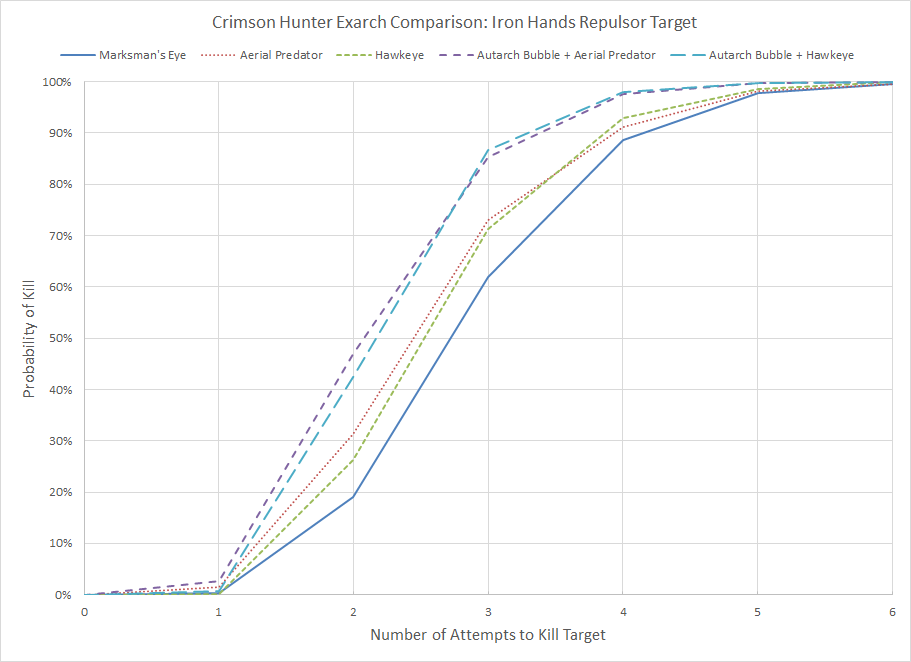The Aeldari got a bunch of new rules in Psychic Awakening, including several new options for every Asuryani Exarch. In this week’s Hammer of Math Kevin Genson looks over some of the options available to the Exarchs and helps you optimize your lists.
Overview
Psychic Awakening includes a major boost for the Aeldari, including several benefits to the Craftworld Eldar in the form of new Exarch powers and abilities. There’s something for everyone, whether you’re fielding Howling Banshees or still have some Warp Spiders in your collection from 2nd edition. Many of these benefits focus on the specialty of each squad and as a result there can be significant overlap. Fortunately with a bit of math we filter things out and focus on the optimal abilities which will provide the most benefit.
Psychic Awakening provides six new powers for each of the nine Aspect Shrines of the Asuryani that replace the core ability from the Craftworld Eldar Codex. There is also a 1CP Stratagem called Exemplar of the <Aspect> Shrine which allows you to take a new ability without replacing the original. Note that much like the Chapter Master ability out of Codex Space Marines you must choose the Exarch powers at roster creation; there is no flexibility to tailor your list in accordance with your opponent. As noted in our review this is not really a great decision on the part of Games Workshop, as it eliminates any flexibility and encourages players to take more “generically” good choices instead of niche abilities which could be more beneficial against certain targets.
Note that this article does not cover the abilities for Swooping Hawks or Warp Spiders. Neither of those Shrines received any powers that are easy to compare in the way that Crimson Hunters or Fire Dragon abilities are. Dark Reapers are also not covered as preferred ability is highly dependent on the weapon the Exarch carries. For a more detailed description of each ability and our thoughts on the abilities, check out the review linked above.
Crimson Hunters

Crimson Hunter Exarchs start with the Marksman’s Eye power, which allows ranged weapons to re-roll 1s to hit. They have two other abilities which can be useful in hunting vehicles. Aerial Predator provides a +1 damage against vehicles with the FLY keyword (which includes Repulsors), while Hawkeye allows the Exarch to ignore the penalty to hit and is effectively a +1 BS bonus.
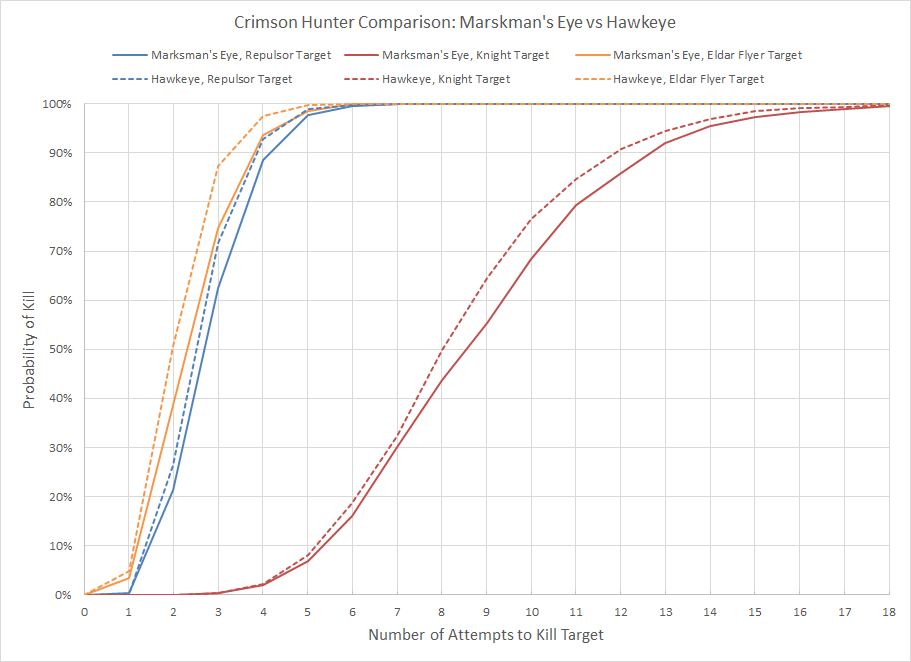
In the graph above each color represents a different target, and the dashed line and solid line are different abilities. The further to the left a curve is the better, indicating that the unit is able to kill the target faster. We already know that modifiers are better than single die re-rolls, and nothing changes here. Under the rules of 8th Edition getting a +1 to hit will always be better than re-rolling values of 1, and since Crimson Hunters will always be moving choosing Hawkeye is the superior choice.
With the prevalence of Repulsors (especially Iron Hands) and flyers in the current competitive meta it may be worth locking in the choice of Aerial Predator. Although this reduces your effectiveness against ground targets, the +1 damage bonus is superior to even Hawkeye. I also added two curves showing the benefits of adding a re-roll hit of 1 effect such as from an Autarch; in a re-roll bubble two Crimson Hunter Exarchs have a roughly 50% chance of killing an Iron Hands Repulsor if they have Aerial Predator.
Dire Avengers
The Dire Avenger Exarch can akimbo a pair of shuriken catapults, giving him some interesting options for increasing his offensive firepower at the expense of a 4++. The first option is Bladestorm, which adds an additional hit every time a 6 is rolled on the hit test for the entire unit. Martial Adept changes the WS and BS to 2+, while Shredding Fire changes the shuriken catapult benefit so that instead of getting AP -3 on a wound roll of 6 the weapon is a flat AP -3. Dire Avengers also get access to Avenging Strikes, which will give the entire squad a +1 to hit and wound once one of the models in the unit has died.
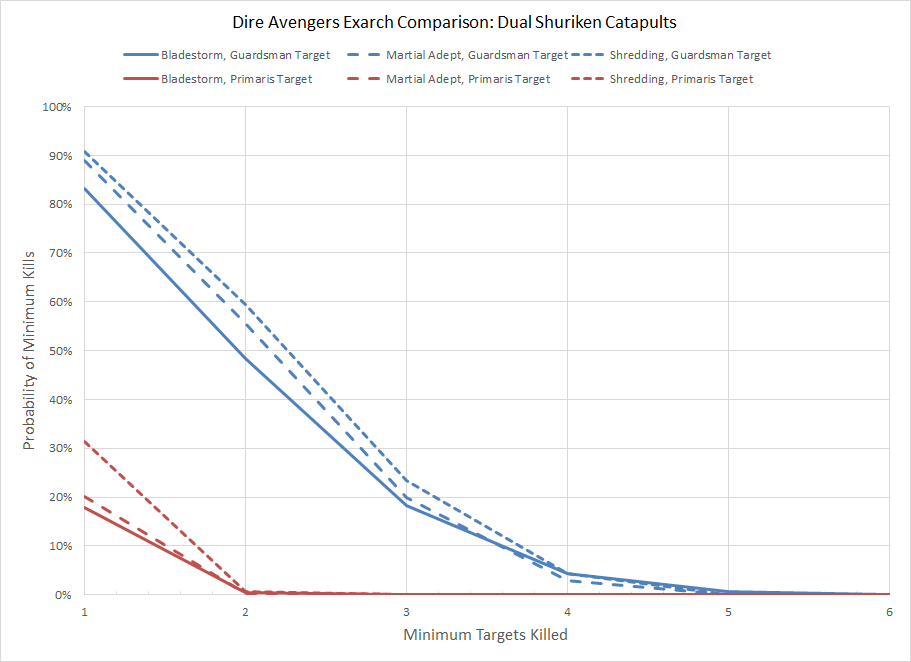
Martial Adept is a trap power that has a vastly limited utility compared to Shredding, which is more beneficial against even Guardsman targets. That said Bladestorm is the superior choice because it applies to the entire unit and not just the Exarch.
We’re not done yet, because there’s also Avenging Strikes. Because Avenging Strikes and Bladestorm scale with the size of the unit, the best way to calculate the effect is with an expected value problem. We know that the number of wounds dealt to the target is a function of the following:
Wounds = Attacks x P(Hit) x P(Wound) x (1 – P(Save)) x (1 – P(FNP)) x D
Assuming a Marine target for the Dire Avengers under Bladestorm the P(Hit) is 0.833, the P(Wound) is 0.5, the P(Save) is 0.5, and the damage is 1. The P(Hit) and P(Save) require a bit of extra explanation due to how Bladestorm and the Avenger shuriken catapult work.
For P(Hit) there are three probable outcomes thanks to Bladestorm. On a roll of 1 or 2 there is no hit. On a roll of 3, 4, or 5 a single hit is registered. On a roll of 6 a pair of hits are counted. In situations like this you can add up the individual events and the probability of their appearance to get the final probability:
P(Hit) = 0 x (1/6) + 0 x (1/6) + 1 x (1/6) + 1 x (1/6) + 1 x (1/6) + 2 x (1/6) = 5 x (1/6) = 0.833
The armor save value is a little more obnoxious. Avenger shuriken catapults are normally AP 0, but become AP -3 on a wound roll of 6. Because the catapult is S4 and will only wound T4 on a 4+ there are three possible outcomes (4, 5, and 6) and only one of them will result in a AP -3 result. So the end result is:
P(Save) = (1/3) x (4/6) + (1/3) x (4/6) + (1/3) x (1/6) = 0.5
So this gives us the final formula for Bladestorm attacks against a T4/3+ target:
Wounds = Attacks x 0.833 x 0.5 x (1 – 0.5) = 0.208 x Attacks
Or 0.208 wounds per attack.
Now we can do the same for the Avengers under Avenging Strike with a +1 to hit and wound. Amusingly enough P(Hit) is the same at 0.833, P(Wound) is now 0.66, and P(Save) is now 0.417 because the AP -3 effect occurs on wound rolls of 5 or 6.
Wounds = Attacks x 0.833 x 0.66 x (1 – 0.417) = 0.321
Or 0.321 wounds per attack, which is 54% more than the wounds per attack by Bladestorm.
The bottom line is that from a mathematical standpoint Avenging Strikes has a 54% greater output than Bladestorm, but with the caveat that you must lose a model before this occurs. Depending on the size of the unit and the threat Avenging Strikes may never be used as the unit could be wiped out (particularly a concern for smaller units). The circumstances revolving around which option is ultimately superior depends on your style of play, the threats encountered, and the size of the unit. A larger unit which is able to withstand casualties is a more appropriate choice for Avenging Strikes, but a 54% output is significant. As is the case with all modifiers any situation with a lower P(Wound) or lower P(Save) is going to see that effect improve even further.
Fire Dragons
One would expect a melta-wielding space elf who has dedicated thousands of years of his life to be good at killing tanks, but unfortunately even the dedication of the Asuryani can’t stop melta from generally being a bad choice in 8th Edition. The Fire Dragon Exarch has two options when it comes to increasing his offensive firepower; Crack Shot for re-rollings 1s or Tank Killer for re-rolling one damage die against models with the VEHICLE keyword (assuming the Exarch has a Fire Pike).

There’s a slight improvement against the Iron Hands Repulsor target, but to be honest the benefit of either ability is so mediocre that’s it’s not really worth taking. If you feel compelled to take Fire Dragons focus on powers that get them in range, like Swiftstep since the probability of hitting something out of range is always 0.
Howling Banshees
Howling Banshees have a variety of interesting powers. The core ability is War Shout, which provides a -1 to hit the squad while in melee. On the offensive side of things the Exarch can take Whirling Blades to get a +1 attack bonus when using most weapons (+2A if using the relatively situational mirrorswords), Piercing Strike to sacrifice 1 attack for a +3S bonus and a flat 3 damage with the Executioner, or Decapitating Strike to deal a mortal wound on an unmodified 6 to hit. On the defensive side the Exarch can use Graceful Avoidance to give the entire squad a 5+ FNP or Disarming Strike to reduce the attacks of a single enemy model by 2.
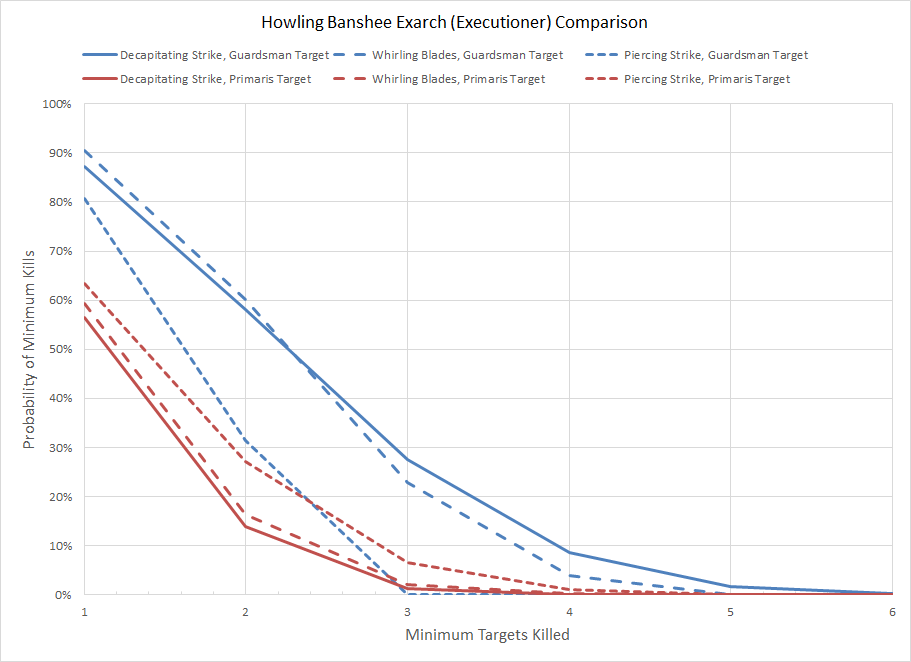
Whirling Blades has a slight advantage over Decapitating Strike for Guardsman, but the difference is minor. Against Primaris Piercing Strike offers a considerable benefit even with the reduction in attacks. It may be better to examine the defensive capability of Howling Banshees. Currently Banshees are seen as units designed to distract and disrupt the enemy; they just don’t put out enough damage to be a major threat. So let’s start off by comparing Graceful Avoidance to Disarming Strike. How many attacks does the unit need to face before the benefit of the 5+ FNP, which scales, is better than a flat reduction of 2 attacks? As with other problems which scale by unit size we can look at the expected value. We can find the equilibrium point by applying the wound equation to both the Graceful Avoidance and Disarming Strike.
Graceful Avoidance: A x P(Hit) x (1 – (P(Save)) x (1 – (1/3)) x D
Disarming Strike: (A – 2) x P(Hit) x P(Wound) x (1 – P(Save) x D
If we set the two equal to each other and, remove like terms we get the following:
A x (2/3) = A – 2
Which balances out when A = 6. So if the Howling Banshee unit faces six or more attacks, then Graceful Avoidance is a superior choice to Disarming Strike. Next we should compare War Shout to Graceful Avoidance. The improvement in resiliency for a bonus in saves or FNP (relative to no save at all) is 1 / (1 – P(Save)). So for example a 5+ FNP provides 1 / (1 – 2/6) = 3/2 = 150% or a 50% improvement in the resiliency of the target. In other words a 5+ FNP effectively adds 50% more wounds to a unit. We know from our modifiers and re-rolls article that a 50% delta requires the original value to be a 5+ or 6+. Any unit with a 5+ WS isn’t going to be much of a threat in melee anyway, so for most situations Graceful Avoidance is the best choice for ensuring survival.
For offensive options the player is encourage to take Whirling Blades for light targets and Piercing Strike against Primaris, but without knowing your opponent ahead of time this is not an easy choice. Defensively, Graceful Avoidance is the preferred solution for most situations.
Shining Spears
Shining Spears are often used as vehicle killers, and their abilities reflect that. The core ability of Expert Hunter allows the Exarch to re-roll wounds against models with the VEHICLE or MONSTER keyword. Psychic Awakening opens up two additional options. Lancer allows the model to score additional hits when an unmodified six is rolled on the hit test, and Heartstrike deals a mortal wound on an unmodified six to hit.
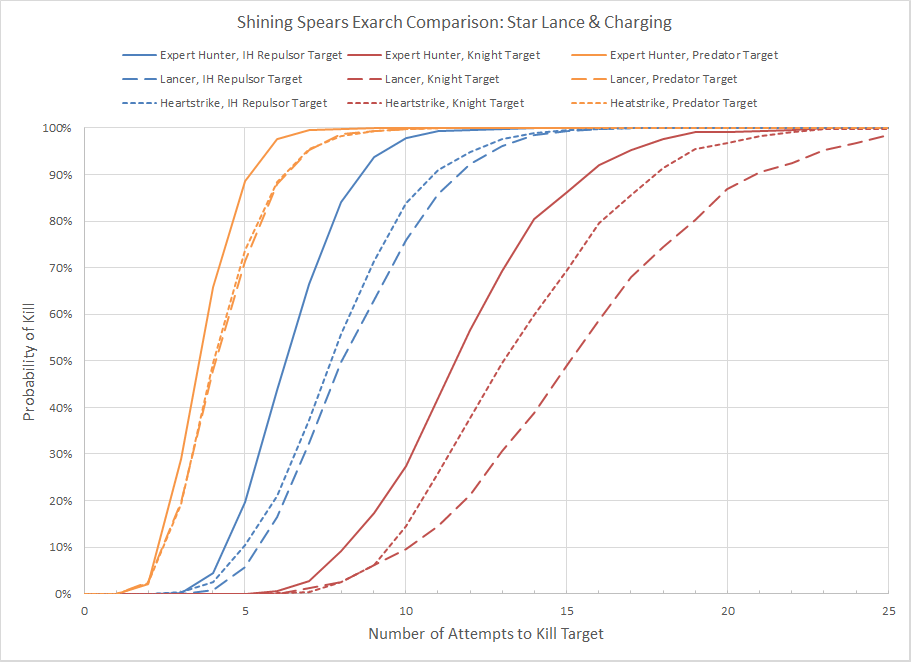
It turns out the original ability is the best, as even with a S8 vehicle targets generally require a 3+ or 4+ to wound. Both Lancer and Heartstrike will only occur on roughly 17% of hit rolls, while Expert Hunter is applicable much more often. For vehicle hunting Expert Hunter remains the superior choice.
Striking Scorpions
From an offensive standpoint the melee-focused Striking Scorpions have four options. The core ability is Sustained Attack which allows the Exarch to make an extra attack on a hit roll of 6. Psychic Awakening provides Crushing Blow, which increases the strength of the Exarch by +2 making him S10 with the claw. Scorpion’s Grasp allows the Exarch to deal a mortal wound every time the hit roll is an unmodified six. And finally Scorpion’s Sting applies to the unit and adds +1 to the Mandiblaster roll. Mandiblasters work every Fight phase; every model in the Striking Scorpion unit rolls a d6 and on a 6 (or a 5 with Scorpion’s Sting) the unit take a mortal wound.
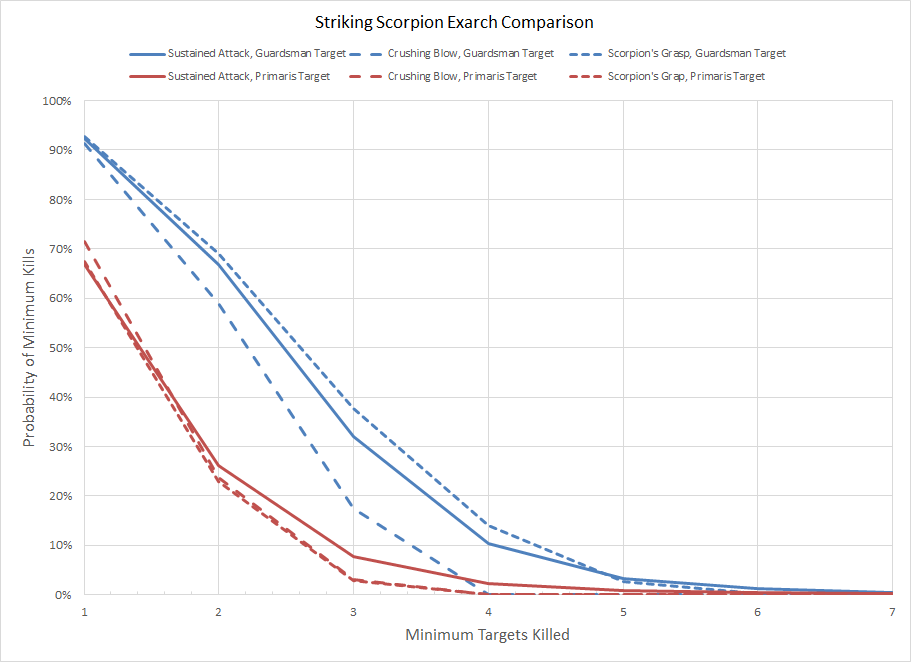
Against infantry targets the difference is fairly minor. Scorpion’s Grasp provides the potential to kill more Guardsman and has a slightly improved chance to kill the first Primaris, but generally overlaps with Sustained Attack. Crushing Blow performed equivalently to Scorpion’s Grasp against Primaris targets and was overkill against Guardsman targets, but as noted in the review the S10 provided by Crushing Blow makes it more useful against higher toughness threats.
Against targets with the INFANTRY keyword it may be worth considering Scorpion’s Sting. The question becomes whether or not the reduced efficacy of the Exarch is offset by the number of mortal wounds dealt by the Mandiblasters. This is an expected value problem similar to the Banshee ability, only we’ll focus on kills instead of wounds to accommodate a Primaris target.
Assuming Guardsman Target and Scorpion’s Grasp we need to take into account the damage dealt by the Exarch, the additional mortal wounds dealt by the three attacks and Scorpion’s Grasp, and the attacks from the Mandiblasters.
EV for Scorpion’s Grasp:
3 x (4/6) x (5/6) x 1 + (3/6) + N/6 = 13/6 + N/6 Kills
EV for Scorpion’s Sting:
3 x (4/6) x (5/6) x 1 + N/3 = 10/6 + N/3 Kills
Setting the values equal to each other we get that N = 3, meaning that so long as there are 3 or more models Mandiblasters will kill more Guardsman.
For Primaris Marines we’ll use Crushing Blow. The numbers are a bit more complicated because the Exarch’s claw will kill a Primaris 2/3 of the time, so we need to include the variable damage.
EV for Crushing Blow:
3 x (4/6) x (5/6) x (5/6) x [(1/3) x (1/2) + (2/3) x 1] + (1/2) x N x (1/6) = 1.157 + N/12 Kills
EV for Spitting Scorpion:
3 x (4/6) x (4/6) x (5/6) x [(1/3) x (1/2) + (2/3) x 1] + (1/2) x N x (2/6) = 0.926 + N/6 Kills
Setting the values equal to each other we get that N=2.778, so once again 3 Striking Scorpions will kill more Primaris Marines. For typical targets with the INFANTRY keyword Scorpion’s Sting will kill the most models so long as you have three or more Striking Scorpions.
Conclusions

Psychic Awakening includes a wide variety of options for Aspect Warrior Exarchs, and in several cases the improvement to offensive firepower is considerable. In other cases the player may be better off focusing on a more utilitarian ability, such as one that improves movement or resiliency. Ultimately it’s a function of the intended use of the unit. Crimson Hunters, Dire Avengers, and Striking Scorpions all received options that can improve their offensive capabilities. The improvement to Fire Dragons was generally mediocre, and players who want to field them are better off looking at making them faster. Howling Banshees have options that can make them more lethal, but where they really shine is in how much harder it can be to kill them in the Fight phase. Many of the units have options which are more useful in certain situations, but because the rules require the player to make these choices when building the roster the flexibility is lost and players are left to pick the most generically optimal choice.
If you have any questions or comments, feel free to drop a note in the comments below, or email us at contact@goonhammer.com — we’re always looking for new things to analyze in Hammer of Math.

